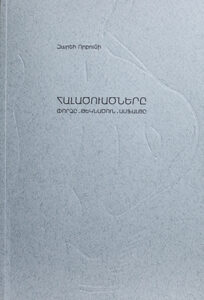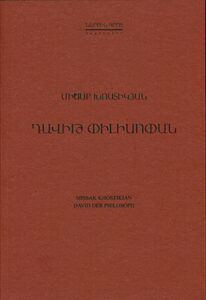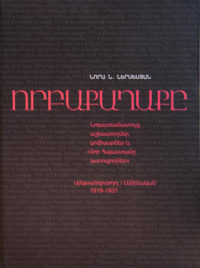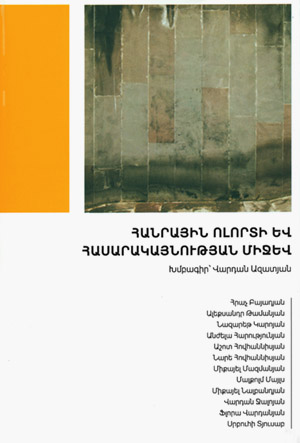Akeldama, v. 2 |
|
|
Vache Sargsyan The second volume of Soviet Armenian writer Vache Sargsyan’s novel Akeldama entitled Permanent Freeze. Letters to Sonia Carol contains the author’s previously unpublished novel which he wrote in 1966 upon his return from his sixteen-year long incarceration in the Gulag camps. The novel was revisited and completed in 1986. It continues the first novel’s The Inimitable Story’s hero Vazgen Darbinyan’s journey through the camps, through which the customs of the exilic life reveal themselves with all their inner complexity. The volume has been supplemented with documents from family archives that in turn shed light upon hitherto unnoticed aspects of Stalinist policies. The volume has been compiled and edited by Siranush Dvoyan. |
 |
The Persecuted, v. 2 |
|
|
Zareh Vorbuni The second volume of the critical edition of Zareh Vorbuni’s works includes the novels An Ordinary Day (1974) and the previously unpublished Tigran (1973-1979) which are the fourth and the fifth novels of the series Persecuted. Both novels depict the exilic experience in the Diaspora, and particularly in Paris and Marseille. The first presents a complete chain of a day-long and the second of six-day long events. With Tigran, an essential turn takes place because of the main hero and due to the circumstances. Tigran, as the other protagonists of the first volume of the series, is persecuted by others. But he also persecutes himself. The volume is complimented with annotations which are based on unpublished archival materials, and which reveal the path in Vorbuni’s work to achieving a completed manuscript and the creative difficulties on it. The volume was compiled and edited by Krikor Beledian. The general editor of the book is Siranush Dvoyan. |
 |
The Persecuted, v. 1 |
|
|
Zareh Vorbuni The first volume of French Armenian writer Zareh Vorbuni’s (Eoksuzian) three-volume publication contains the first three novels of Vorbuni’s series The Experiment (1929), The Candidate (1967) and The Asphalt (1972). In these novels the writer presents the experience of a generation that lived through the loss of home as well as the loss of the familiar surrounding as a possibility of opening up towards and experiencing what is foreign. Vorbuni is the first of those Diaspora writers who experience the Diaspora inwardly through literature as a tragedy of an irretrievable loss of home and homeland on the one hand, and as a possibility for intellectual subjectivization on the other hand. Thus, it is of no coincidence that the title of the series of novels carries – and the pen name of the author affirms – this very paradoxical experience of twentieth-century Armenian identity. The publication contains annotations that identify the bibliographical differences between the first publications of the novels, the original manuscript and the initial French translations. The volume includes Marc Nichanian’s chapter on Zareh Vorbuni. |
 |
David the Philosopher |
|
|
Missak Khostikian The book contains the translation of theologian-philosopher Missak Khostikyan’s doctoral thesis that Khostikyan defended in Bern in 1907. The dissertation is published alongside its German original and is supplemented with extensive annotations. The book also includes valuable documents that reveal the manifold of activities that Khostikyan was engaged with in Armenia as well as previously unpublished official documents and letters from his student years. The volume concludes with a critical addendum that contains Ashot Grigoryan’s and Vardan Azatyan’s studies. The book ends with a concise chronology of Khostikyan’s life and works. |
 |
Akeldama, v. 1 |
|
|
Vache Sargsyan Vache Sargsyan’s novel Akeldama is a monument of Soviet Armenian literature of exile that has thus far remained obscure. Written in a fictional form throughout the 1960s in the aftermath of the author’s return from sixteen years of exile in the Gulags the novel presents Sargsyan’s reminiscences of his exilic experience and his attempt to revisit the characters of his friends. Sargsyan was arrested in 1941 when, still a youth, he had started teaching at the village school of Verin Talin. In the context of Khruschev’s policies of destalinization he was acquitted and released in 1956. After his return from exile he continued his literary and public activities by participating in the liberation movements of his time. The first volume of the novel The Inimitable Story is seeing publication for the first time and is accompanied with Siranush Dvoyan’s critical evaluation of Vargsyan’s life and literary legacy in the context of the literature of exile. The volume also includes documents related to the publication of the novel. |
 |
Who Made the Revolution |
|
|
Vardan Azatyan The small book published on the occasion of the first anniversary of the revolution in Armenia in April-May, 2018, presents the author’s understanding of the event. It aims to think and conceive of the event on its own terms. And since revolutions are essentially creative processes their adequate understanding cannot succeed without an imaginary thinking. Thus, the book does not present an analysis of the revolution. Rather it is a philosophical undertaking about the cultural forces capable of making a revolution in Armenia. |
 |
The City of Orphans: Relief Workers, Commissars and the “Builders of the New Armenia”, Alexandropol/Leninakan 1919-1931 |
|
|
Nora N. Nercessian The book tells the story of the American orphanages located in the former Tsarist military barracks Kazachi, Seversky, and Polygon in Alexandropol (present day Gyumri) from 1919 to 1931. This exceptional work on the history of the orphanage, based on local and international, published and unpublished sources, articles, archival documents, reports, memoirs, photographs, tells the stories of tens of thousands of orphans and sheds light upon the historical and political events in the midst of which they were brought up and educated. The City of Orphans provides a unique perspective for understanding the complex political nuances of the Dashnak, Soviet and US policies of the time. |
 |
Inquiries into Photography |
|
|
Karin Grigoryan, Vahe Budumyan Inquiries Into Photography is a sourcebook on photography. The authors Karin Grigoryan and Vahe Budumyan have years of experience in teaching and translating texts on photography into Armenian. The book has two interrelated parts, with the first articulating the main historical and theoretical questions in photography and the second dedicated to technique. The book concludes with a glossary of terms. It was published in collaboration with Actual Arvest Press. |
 |
Israel Ori and the Armenian Liberation Idea |
|
|
Ashot Johannissyan Israel Ori and the Armenian Liberation Idea is the first volume of Nerqin Grots Book Series. The volume presents the Armenian translation of historian and politician Ashot Johannissyan’s PhD dissertation which he defended in Munich in 1913, along with its German original. The book is complimented with Johannissyan’s working notes, as well as with extensive editorial notes which allow the reader to trace the development of the dissertation up until Johannissyan’s double volume monograph Episodes in the History of Armenian Liberation Thought. The book, in addition, contains the opinions of Johannissyan’s German professors regarding their student’s dissertation as well as Johannissyan’s speech delivered later in 1955 on the occasion of the defense of his doctoral dissertation in Yerevan. The book concludes with Vardan Azatyan’s study of Johannissyan’s life and work. |
 |
Image, Narrative, History, v. 1 |
|
|
Marc Nichanian The double volume work by contemporary Diaspora Armenian philosopher Marc Nichanian entitled Image, Narrative, History is a philosophical study dedicated to the three key problematics in contemporary thinking mentioned in the title. The book refers to the writings of the twentieth century Diaspora Armenian and French writers Maurice Blanchot, Georges Bataille, Krikor Beledian, Zabel Yesayan, Shahan Shahnour and Zareh Vorbuni. The first volume is dedicated to the literary and philosophical works of Bataille and Blanchot which Nichanian considers from the perspective of the relationship between the survivor and the image. |
 |
Image, Narrative, History, v. 2 |
|
|
Marc Nichanian The second volume is dedicated to the works of four Western Armenian writers – Zabel Yesayan, Krikor Beledian, Shahan Shahnour and Zareh Vorbuni. Nichanian considers the latter from the perspective of the figure of the survivor, the problems this figure poses and the haunting presence of the image in them. |
 |
Between The Public Sphere and Öffentlichkeit |
|
|
Editor Vardan Azatyan The volume Between The Public Sphere and Öffentlichkeit is a product of collaboration between The Johannissyan Institute and Utopiana cultural-creative organization, within the framework of Spaces program. The volume is compiled and edited by Vardan Azatyan with an extensive introduction by the editor. The contributions in the volume provide paths to thinking the public by discussing the notion and its different manifestations. The volume could be considered as the continuation of the anthology Public Sphere: Between Contestation and Reconciliation published in 2007 by the National Association of Art Critics (AICA Armenia) (Editor Vardan Azatyan). |
 |




